Shopping for hanging lighting can be a bit overwhelming. With so many options, falling in love with a light and imagining how perfectly it will fit into your design is easy – only to be stuck because you’re not sure if it’s not the right size or shape. Keep reading to learn more about the many points that factor into choosing hanging light fixtures for your home.
Types of Hanging Lights
Hanging lights serve many different functions. From grand chandeliers to small pendant lights, there are three main types of hanging lights to choose from based on your needs.
Ambient Hanging Lights
Ambient lighting or general lighting is the primary light source in a room. This light fixture provides illumination without being overpowering. Chandeliers, recessed lights, wall- and ceiling-mounted lights fall into the ambient light category.
Chandeliers
Chandeliers may bring to mind ornate, crystal-dripping lights that take up all the space in your room. While you can undoubtedly find something sparkly and grand, there are many chandelier options to fit every style.
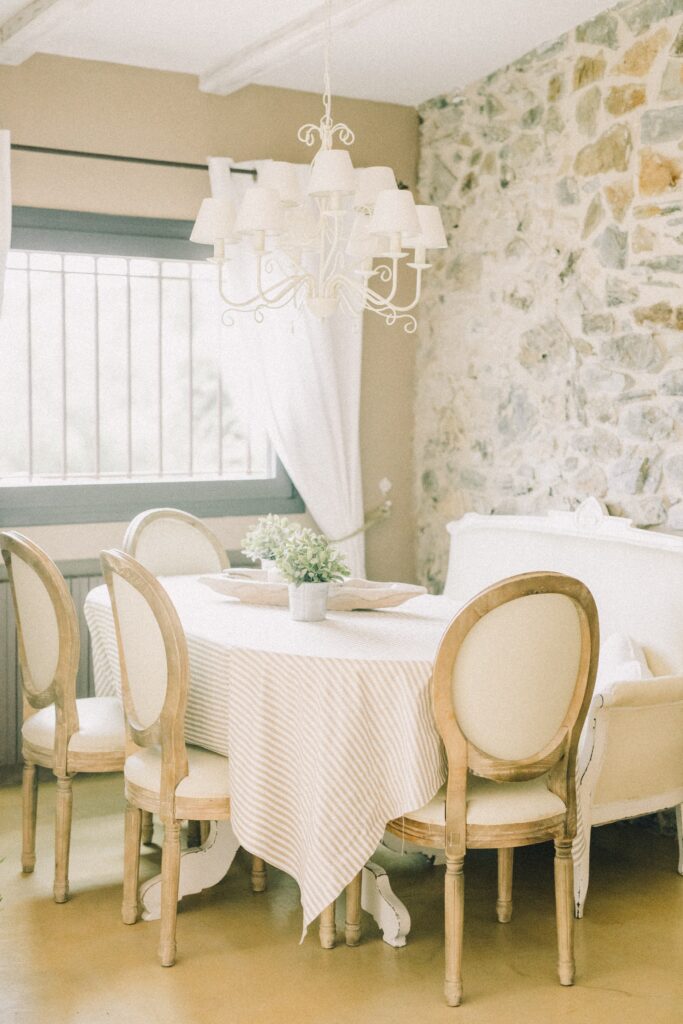
Flush Mount
A flush mount light sits right against the ceiling and creates a minimalist look that is not super obvious. This style of mounted light is often seen in bathrooms, hallways, and other rooms where overhead space may be limited.
Semi-Flush Mount
A semi-flush mounted light has a short down rod that drops the fixture down from the ceiling. This style adds a decorative touch without being super distracting.
Recessed Lighting
This lighting style is a great way to add light throughout the entire space. The lights sit inside cans that are recessed into the ceiling. You can choose from various can and trim styles to match a space’s aesthetic.
Accent Hanging Lights
Accent lighting is exactly as it sounds; it accents a specific place in the room. Track lighting is an excellent example of hanging accent lighting. If you want to illuminate a particular piece of art or an area that needs more light for reading, accent lighting is often the answer.
- Standard Track Lighting: This is the most typical style of track lighting. You can choose the length you need, and the lights can be moved along the track to suit your needs.
- Fixed Track Lighting: Like the standard track, the lights are in a fixed position that cannot be adjusted once installed.
- Swing Arm Track Lighting: Swing arm track lighting allows you to adjust the ends of the arms to fit the arrangement of your space.
- Monorail Track Lighting: A monorail track light is customizable in shape. It is perfect for unusually shaped islands as you can curve the track to provide light exactly where you need it.
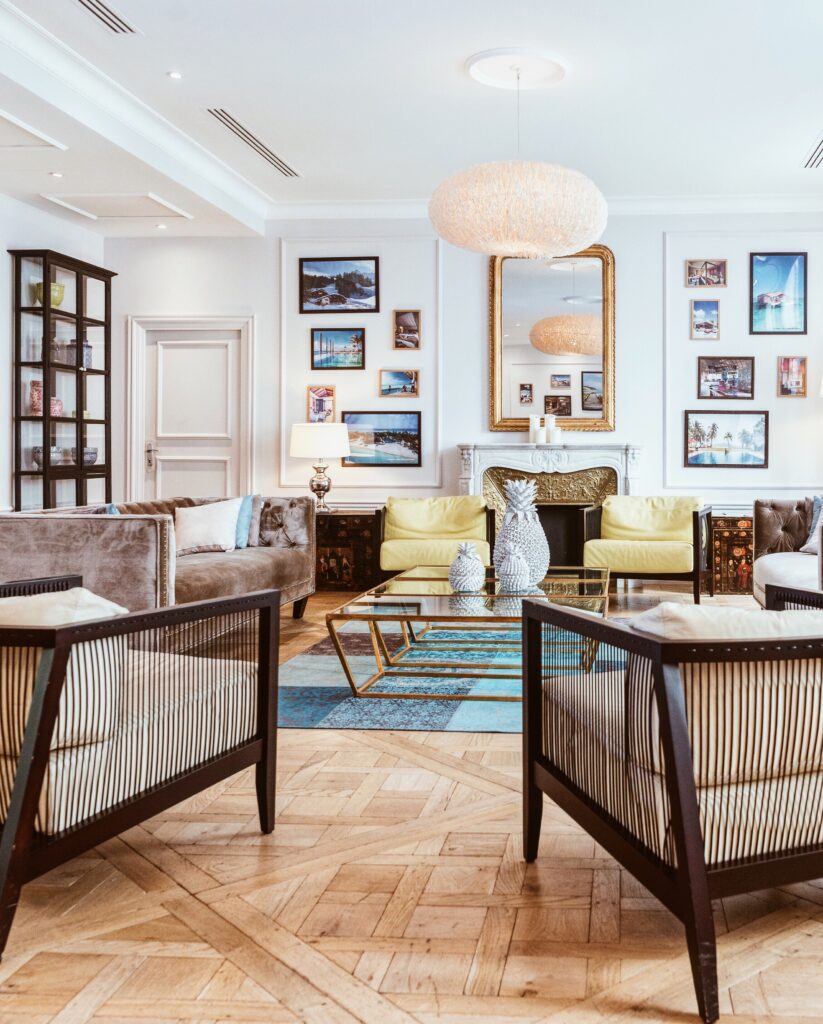
Task Hanging Lights
Task lighting is added to a space to illuminate a specific workspace. Hanging pendant lights are typical task lights added in the kitchen over the island, stove, or sink. This light style allows you to turn on just what you need when working in your space.
Hanging Light Placement
When planning your lighting placement, you first want to look at the room at dusk and in the dark. Decide what areas of the room need illumination and at what level. Areas that need lighting include reading areas, walkways, seating areas, shelves, and special decor.
Finding the right illumination level usually means a combination of hanging light fixtures and making sure they are installed with the correct spacing. Here are some general spacing guidelines for installing your lighting.
Kitchen
Two Pendant Lights Over Kitchen Island
- At least 30 inches from the center of the island
- 30-32 inches from the countertop to the top of the pendant

Three Pendant Lights over the Kitchen Island
- At least six inches from the edge of the island
- 30-32 inches apart
- 30-32 inches for the countertop to the bottom of the pendant
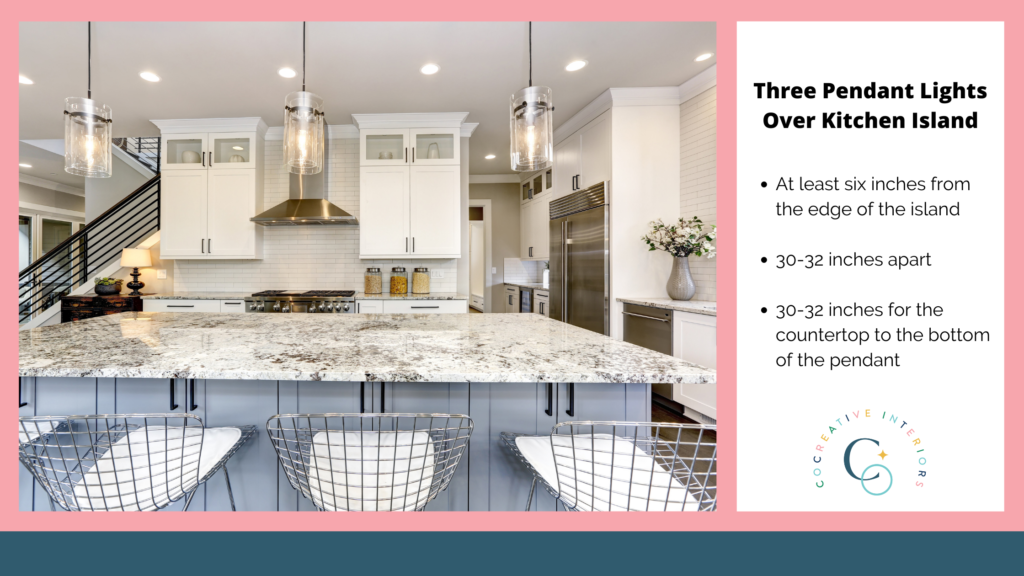
Dining Room
Chandelier in Dining Room
- At least six inches from the edge of the table on each side
- 33-34 inches from the tabletop to the bottom of the chandelier on an 8-foot ceiling
- For every extra foot of ceiling height, hang the chandelier three inches higher
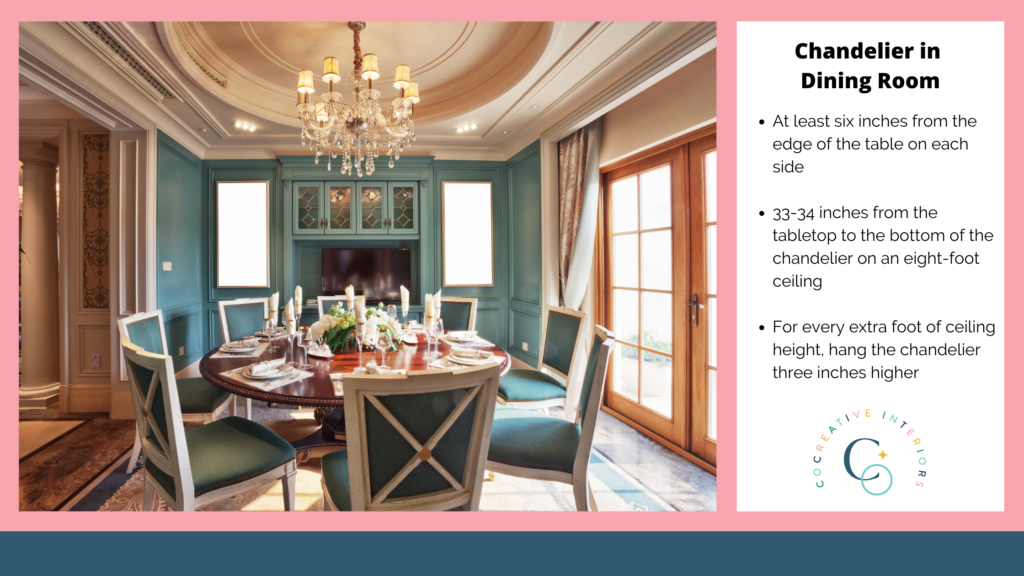
Living Room
- Hang the light fixture at the center point of the room or the center of the main seating area
- If the ceiling is two stories, change the fixture no lower than the 2nd floor
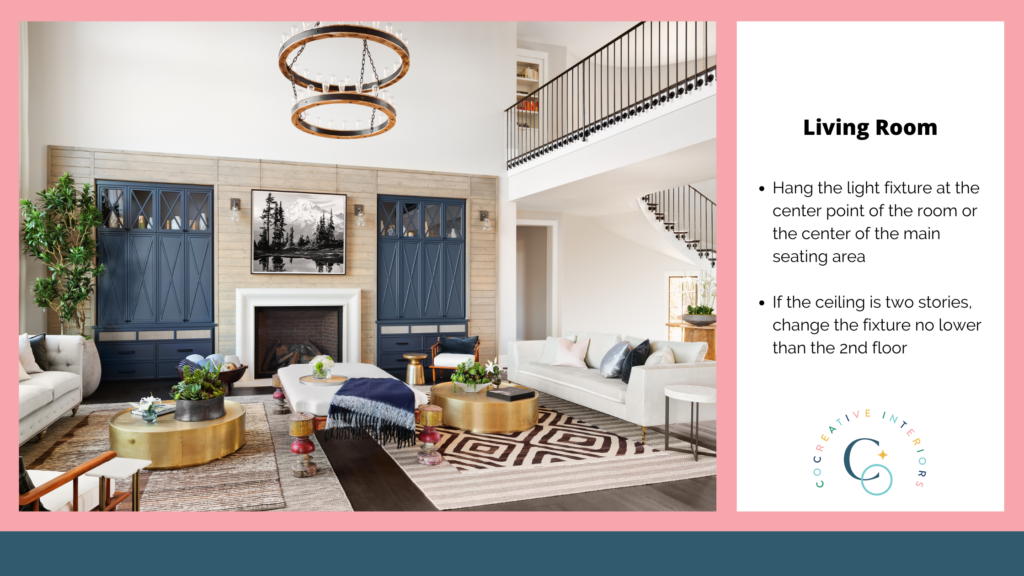
Pendant Light Placement Around the Home
- At least seven feet from the floor to the bottom of the pendant for walking clearance
- Add 2.5-3 inches of height for each additional foot of ceiling over 8 feet
- Hang pendants at least four feet from the surrounding walls
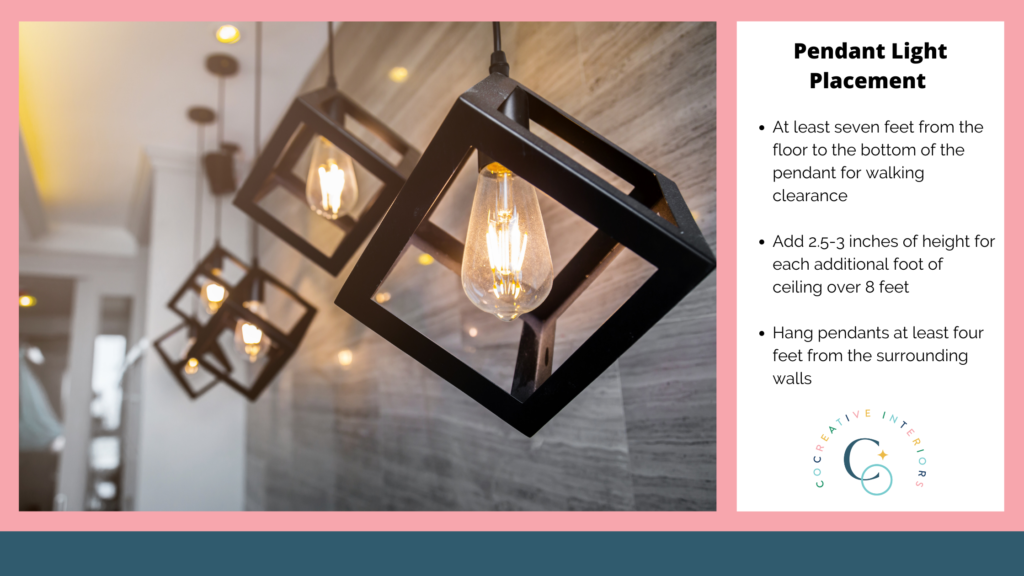
Additional Considerations When Choosing Hanging Lights
In addition to choosing lights that are beautiful and will add to the functionality of your space, there are some other points you need to consider for safety and usage.
Are the Lights UL Listed?
UL, or Underwriters Laboratories, is the company that tests the safety of consumer products. A UL certification means the product has been tested and deemed safe and consumer-friendly.
Humidity Rating
All lights have a location rating to help you determine how much moisture your light can handle. This rating will help determine where it is safe to place the light without getting damaged by moisture. The ratings to look for are:
- Dry-Location: Designed for minimal moisture exposure, these lights are meant to be placed indoors only.
- Damp-Location: These lights are designed for moist environments, such as covered outdoor areas like porches and patios. These lights cannot handle direct moisture exposure, but slight dampness is ok.
- Wet-Location: This rating means the light can handle direct water exposure and can be used indoors or outdoors without safety or damage concerns.
What Hanging Light Features Do You Want?
Dimming Feature: A dimming feature allows you to increase or decrease light based on your needs or the mood. Dimming lights can change the room’s ambiance for get-togethers and movie nights or simply add a bit of coziness to a space.
Swag Light Installation: Installing a hanging light with a swag feature means draping the lights from the ceiling using a chain. Doing so can be an aesthetic choice, or functional if the electrical ceiling box is not in the right place and you don’t want to move it. Swaging a new light is much easier than moving an electrical box.
Sloped Ceiling Adaptable: If your ceiling is sloped, you need to ensure that your light can be installed

correctly. Certain hanging lights are made to adapt to a sloped ceiling with special housing for the light fixture so that the beam of light shines straight down.
LED Integrated: These fixtures have LED technology built-in, which means the LED light and fixture are one unit. While integrated lighting has more straightforward installation, it’s also harder to upgrade and maintain. If you do not have LED integration, you can purchase LED bulbs to achieve the same energy efficiency.
Choosing the Right Light Bulb
After you have your hanging light installed, check to be sure you have the right light bulb for ambiance and usage. Just like light fixtures, there are MANY light bulb options to consider. When choosing the best bulb for your needs, understanding a bit of the science behind light bulbs can be helpful.
Lumens and Watts
Lumens and watts are the measurements that determine light output and energy use.
Lumens are the measurement of how much light is emitted from the bulb. More lumens means the light is brighter, while fewer means dimmer. A standard 100-watt light bulb produces about 1600 lumens.
Watts is the measurement of energy the lightbulb uses. Lower wattage uses less energy and can reduce your electric bill. Consider compact fluorescent bulbs or LEDs if you want a bright output but at a lower wattage. They have a lower wattage but emit the same light level as traditional incandescent bulbs. Contrary to common belief, wattage does not have any connection to a light’s brightness.
When choosing your wattage, never exceed the maximum wattage for your light fixture. Doing so can create a safety issue and damage the light.
Light Color
Light color is measured on the Kelvin scale. The values range from soft white to daylight. A lower Kelvin value means the light has a more yellow hue, while higher Kelvin values give off a white or blue hue.
- Soft white: the standard color of incandescent bulbs that falls on the yellowish side of the Kelvin scale and is perfect for bedrooms, living rooms and highlighting dark woods in the home.
- Warm white: falls between yellow and white on the scale and works well in kitchens, home offices and bathrooms.
- Bright white: falls between white and blue on the Kelvin scale and works well in kitchens and bathrooms with chrome or white fixtures.
- Daylight: falls in the blue range and makes for excellent task lighting as the light is easy on the eyes and provides bright light.
Types of Lightbulbs

Light-Emitting Diode (LED)
LED lights are one of the most energy-efficient light bulbs on the market. It gives no heat, contains no mercury, and emits a bright light. They provide directional light, so they are great for task lighting. Some light fixtures come with LED lights built into the unit and are referred to as integrated LED. They can last almost 50,000 hours, so you can also install them in places that are hard to reach since you will not have to change them too frequently. As technology has improved, so has the color temperature of LED lighting, making them much more useful in a variety of settings.
Incandescent
This bulb type used to be the industry standard, but new energy efficiency requirements mean that these bulbs are out of production. Some specialty sizes and shapes will still be available, but they are no longer sold as widely. This bulb type lasts for about a year and uses a filament heated inside the bulb to produce light.
Compact Fluorescent (CFL)
CFLs are energy-efficient and can emit a wide range of colors depending on the bulb. When you turn on a CFL bulb, they need to warm up, so the light will not be immediately at the brightest level. They are less expensive than LED lights and can last longer than incandescent lights. These lightbulbs contain mercury, so you want to handle them carefully. Once they burn out, they are recyclable.
Halogen
Halogen bulbs give off a white light that simulates mid-daylight. They are energy-efficient and dimmable. They have the shortest lifespan and heat up quickly, so be sure to keep them away from hazardous materials.
Adding any sort of lamp or light fixture is an addition to the design of your room. Anything you choose should complement your existing decor and offer the right amount of illumination. If you would like help selecting the perfect light for your space, get in touch! Whether you are looking for a single fixture or need help designing your entire room, we are here to help. You are invited to connect and book your complimentary discovery call.

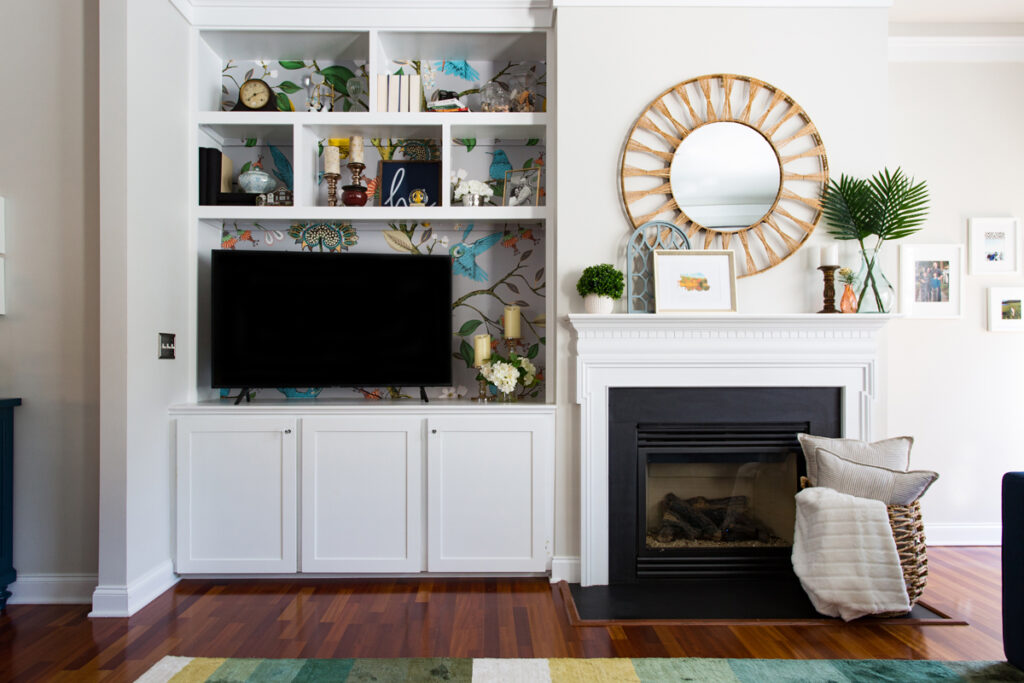


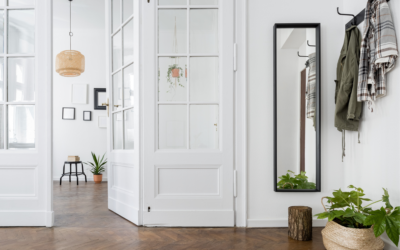
0 Comments